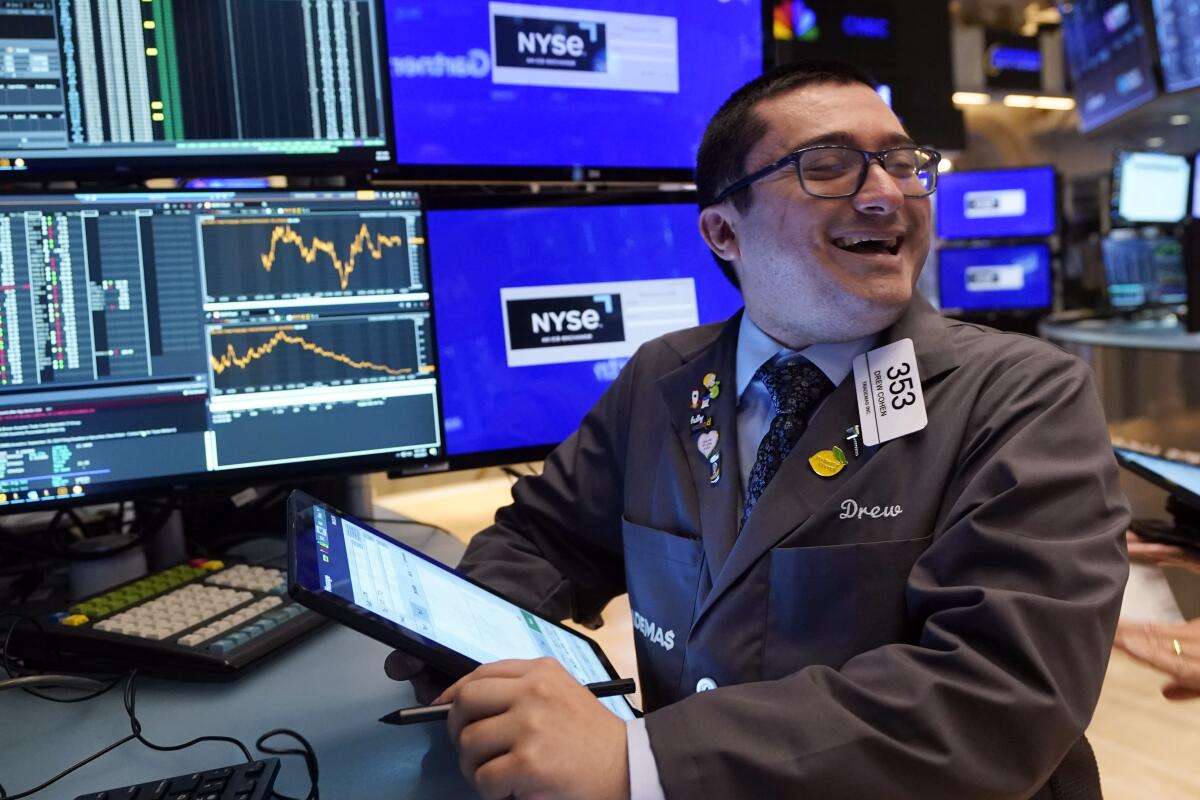Wall Street slips after a morning rally evaporates and some AI stock darlings drop

- Share via
NEW YORK — U.S. stocks slumped Wednesday after a morning rally evaporated, but the losses on Wall Street weren’t as bad as the manic moves that racked markets worldwide over the last week.
The Standard & Poor’s 500 slipped 0.8% after an earlier jump of 1.7% petered out. The Dow Jones industrial average fell 234 points, or 0.6%, while the Nasdaq composite dropped 1%.
Stocks swung lower as Nvidia, one of Wall Street’s most influential companies, went from a morning gain of 4.4% and pushing strongly upward on the S&P 500 to a loss of 5.1% that made it the index’s heaviest weight. Nvidia and other major tech stocks have been struggling in the last month on worries their prices shot too high amid Wall Street’s frenzy around artificial intelligence technology.
A profit report from Super Micro Computer, whose stock more than quadrupled in less than three months to start the year, helped further damp excitement around AI. Even though its revenue soared 143% in the latest quarter, profit for the company that sells server and storage systems used in AI and other computing fell short of analysts’ heightened expectations. Its stock tumbled 20.1%.
Still, other signals in the market showed less fear than in prior days when sharp losses cascaded globally. The S&P 500 is coming off a 1% rally that broke a brutal three-day losing streak in which it tumbled a bit more than 6%.
Several reasons were likely behind the slide for markets worldwide, and one of them centered in Japan seems to be calming. The Bank of Japan raised its main interest rate a bit last week in a small move that sent aftershocks worldwide. It scrambled a favorite trade among some hedge funds and other investors, who borrowed money for very cheap in Japanese yen and then invested it elsewhere around the world.
Speaking to business leaders in the northern island of Hokkaido, Shinichi Uchida, deputy governor of the Bank of Japan, acknowledged the recent market turmoil, which was also triggered in part by concerns about the slowing U.S. economy.
Japan’s central bank can afford to wait, he said, and “will not raise its policy interest rate when financial and capital markets are unstable.” He also said he believed the U.S. economy would have a “soft landing” and avoid a recession, even if fears have risen the Federal Reserve has kept interest rates too high for too long in hopes of stifling inflation.
The Japanese promise offered a balm for markets nervous about additional moves by the Bank of Japan, which only recently ended its years-long campaign to keep interest rates below zero.
But it also highlights how risks may remain, suggesting that there’s still room left for the popular “carry” trade to unwind and that some hedge funds and other investors may “still remain offsides,” according to John Lynch, chief investment officer for Comerica Wealth Management.
Japan’s rate hike last week sent the value of the Japanese yen soaring, and the resulting exit of investments by those hedge funds probably slapped turbochargers onto market losses, including Monday’s plunge for the Nikkei 225. That was its worst since the Black Monday crash of 1987.
The value of the Japanese yen is one of the first things Darrell Cronk, chief investment officer for wealth and investment management at Wells Fargo, checks now when he wakes each morning because it shows how much the “carry” trade is unwinding.
The other thing Cronk checks is the two-year Treasury yield, which he says shows where the market wants or needs the Federal Reserve to take its main interest rate.
Treasury yields tumbled sharply Monday, when fear in the market was spiking and investors were speculating the Federal Reserve may even have to call an emergency meeting to cut interest rates quickly. But they’ve stabilized since then.
The yield on the two-year Treasury was holding steady at 3.99% on Wednesday, where it was late Tuesday.
The expectation on Wall Street is for the Fed to cut its main interest rate at its next scheduled meeting next month by either the traditional quarter of a percentage point or a more severe half of a point.
In the meantime, earnings reports from the biggest U.S. companies continue to roll in, and the growth for those in the S&P 500 index may end up being the best since 2021, according to FactSet.
Walt Disney Co. delivered stronger earnings for the latest quarter than analysts expected, and its streaming business reported a profit for the first time. But its stock nevertheless fell 4.5% after it warned that recent softness it saw at its U.S. theme parks could continue for “the next few quarters.”
Airbnb tumbled 13.4% after its profit in the second quarter fell short of analysts’ expectations, and it told investors that it saw some signs of slowing demand in the U.S.
Helping to limit the market’s losses was Apple, which rose 1.2%. It clawed back some of its losses from earlier in the week after Warren Buffett’s Berkshire Hathaway disclosed it had slashed its ownership stake in the iPhone maker.
All told, the S&P 500 fell 40.53 points to 5,199.50. The Dow dropped 234.21 points to 38,763.45, and the Nasdaq composite fell 171.05 points to 16,195.81.
In stock markets abroad, indexes climbed across much of Europe and Asia.
Choe writes for the Associated Press.
More to Read
Inside the business of entertainment
The Wide Shot brings you news, analysis and insights on everything from streaming wars to production — and what it all means for the future.
You may occasionally receive promotional content from the Los Angeles Times.










